Proper Spill Kit Maintenance: A Guide
At SpillShop, our focus is on minimising the damaging environmental and financial effects of pollution incidents by helping our customers first prevent, and then clean up, spills. One of the first lines of defence in the case of a spill at your facility or business are spill kits. We stock both Vehicle Spill Kits and Wheelie Bin Spill Kits on our online store, which contain a range of components to aid you in cleaning up and containing spills. Spill kits are particularly effective for pollution incidents because of their ability to be easily transported to the site of a spill. Depending on the grade used, spill kits are also able to absorb most types of liquid spills including water, oil, fuel, solvent, mild alkalis and acids, and other chemicals.
This month, learn how to properly maintain the spill kits at your facility with this simple guide:
- Ensure that employees are educated in spill response and equipment
The first step to proper maintenance of your spill kit is to make certain that your employees are educated in spill response procedures and equipment. Your facility should already have an emergency spill response procedure in place in line with EPA regulations, meaning that all your employees understand how to use a spill kit to contain a spill. Not only will this result in an efficient response if a pollution incident occurs, but it also ensures that your entire team takes responsibility for safety in the workplace, including spill kit maintenance.
- Check the spill kits in your facility on a regular basis
Spill kits should be maintained on a regular basis, with checks undertaken at least once every three months. Depending on the nature of your business and the associated risk factors, it may be necessary to check spill kits more frequently. You could select one team member to routinely check all the spill kits in your facility, or even have several employees take responsibility for one spill kit each. Keeping a list of the type and quantity of components included in each spill kit will make these routine checks faster and decrease the likelihood of having missing or outdated equipment.

- Keep a supply of spill kit components on site for restocking
Using an itemised list will make it easy to determine whether your spill kit needs restocking. During a routine check, the assigned team member should not only determine whether all contents are present, but also whether the components are all in working order or need to be replaced. A supply of spill kit components should also be kept on site for restocking. That way, you will never be caught short of essential supplies during a pollution incident. Need to restock your spill kit? SpillShop supplies a complete range of replacement spill kit components, from disposal bags and security tags to wheelie bins and personal protective equipment.
- Locate spill kits strategically for effective spill response
Spill kits need to be strategically placed within your facility for effective and rapid spill response. Both vehicle spill kits and wheelie bin spill kits should be located in secure but easily accessible locations, with no objects or machinery nearby. Having easy access to your spill kit could mean the difference between containing a spill or having it enter a drain or waterway. Clearing away any objects or rubbish which might block access to spill kits in the event of an emergency should form part of your routine maintenance check.
- Include spill kits in the maintenance schedule of the business
The last step to ensure proper maintenance of your spill kits is to incorporate spill kit checks into the maintenance schedule of your business. Without regular checks the depletion of your spill kit might go undetected, resulting in disastrous consequences for your business and the surrounding environment. Not only can spills affect your finances and reputation, but you could also find your facility judged non-compliant with current regulations during an unannounced site inspection from the EPA, possibly leading to a fine or even prosecution. With so much at stake, it makes sense to check that the spill kits at your facility are operational and strategically located for effective spill response.
Unsure which spill kit is the best fit for your facility? Visit the SpillShop FAQ page for more information on spill kits, or Contact Us directly if you would like to discuss your needs further. SpillShop now exports to New Zealand, Papua New Guinea, Indonesia and the Philippines. For more information on our services in each of these countries, head to our Export page.


